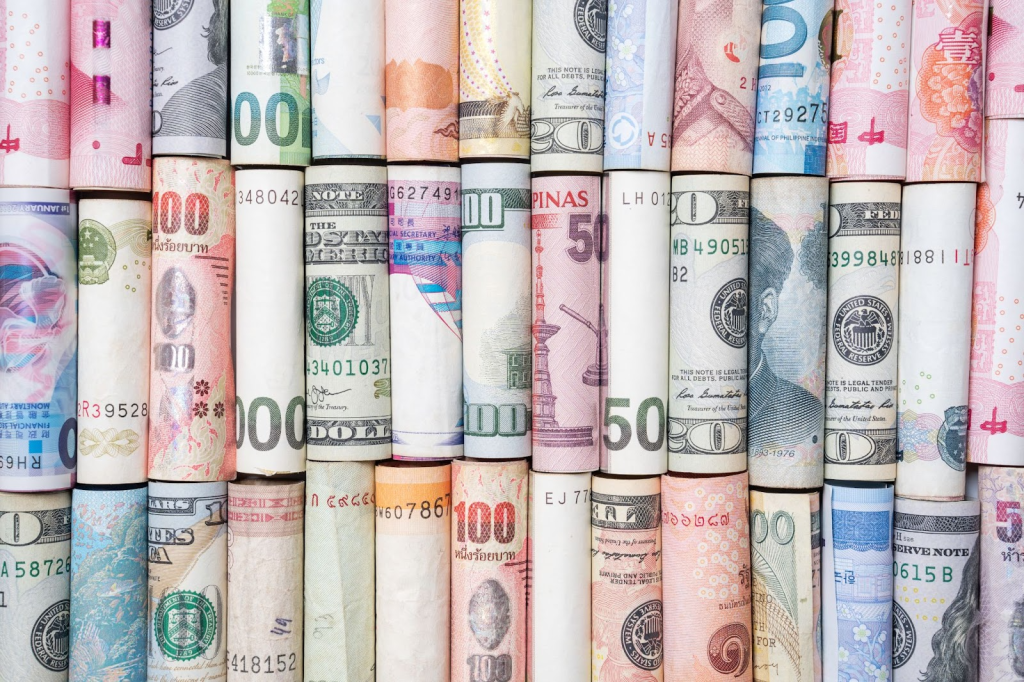Global equity markets posted healthy gains in August, with bond returns being subdued. Investor sentiment was supported by a strong US corporate earnings season. Profits broadly outperformed analysts’ expectations, reinforcing business confidence and positive sentiment. One of the most anticipated, Nvidia, beat overall sales and earnings forecasts, though its data center revenue fell short.
The U.S. labour market showed signs of cooling, with July’s non-farm payrolls report revealing a slowdown in job creation, only 73,000 jobs were added, and previous months were revised downward. At the Jackson Hole symposium held on August 22, Federal Reserve Chair Jerome Powell had a dovish tone, acknowledged that “downside risks” to employment are rising and stating that a “the shifting balance of risks may warrant adjusting our policy stance.” The market took this as an indication of a rate cut at the Federal Reserve’s next meeting on the 16th of September.
Political interference in economic institutions became a focal point after President Trump dismissed Bureau of Labor Statistics Commissioner Erika McEntarfer on August 1, citing alleged data manipulation following the weak jobs report. Later in the month, Trump also attempted to remove Federal Reserve Governor Lisa Cook, citing mortgage fraud allegations. Cook refused to resign and filed a lawsuit challenging the dismissal, arguing it violated the Federal Reserve Act and lacked legal basis. While markets reacted with muted volatility, the legal proceedings could set a precedent that will have long-term implications for central bank autonomy.
In Europe, French Prime Minister François Bayrou called a vote of no confidence for the 8th of September, after failing to secure support for his proposed austerity budget. Opposition parties have pledged to vote against the government, making Bayrou’s defeat likely and raising the risk of a leadership change or parliamentary dissolution. The proposed €44 billion in budget cuts, including the removal of public holidays, has sparked widespread backlash and led to increased volatility in French markets.

Stocks and Commodities
Global developed market equities, measured by the MSCI All-Country World Index, rose 2.6% in August, with Japan’s TOPIX and Canada’s TSX Composite leading performance, in USD terms. The Japanese rally was supported by the US-Japan trade agreement finalized in late July and stronger-than-expected domestic data. Japan’s economy grew 0.3% quarter-on-quarter in Q2, exceeding forecasts, while core machinery orders, a key indicator of the level of corporate investment, rose 3% month-on-month in its latest release.
In Canada, The S&P/TSX Small Cap Index surged 9.3%, significantly outpacing the global outperformance of 5.0% experienced by the broader S&P/TSX Composite. This strength was largely driven by a rally in the Materials sector, fueled by rising prices in both precious and industrial metals. Companies like Capstone Copper Mining saw strong momentum following robust second-quarter earnings, while Shopify added to the rally with solid tech sector results. Financials and pipelines also contributed positively, contrasting with a modest decline in Consumer Staples. The rebound in risk assets was supported by easing tariff concerns, which helped lift sentiment around resource-linked equities. As gold reached all-time highs, the TSX’s resource-heavy composition, with over 10% allocated to gold companies, was a key factor in outperformance.
In the US, the S&P 500 gained 2.0% over the month, despite mid-month volatility triggered by downward revisions to prior non-farm payroll figures and a report from MIT suggesting that 95% of enterprise AI pilot programs failed to deliver measurable revenue growth. Nonetheless, a release of strong second-quarter earnings provided support, with approximately three-quarters of S&P 500 firms beating forecasts by the widest margin since 2021. The August PMI survey was also optimistic, particularly in manufacturing. Additionally, the U.S. government announced an $8.9 billion investment for a 10% equity stake in Intel, aimed at bolstering domestic semiconductor production.

European equities posted more subdued gains, with the MSCI Europe ex-UK index rising 1.2%. The eurozone composite PMI edged up to the expansionary number of 51.0 in August, its highest in 12 months, driven by manufacturing strength and a modest rise in new orders. Loan growth was reported to be robust in July, supporting economic activity. French equities underperformed, dragging down broader European returns. The CAC 40 fell 0.9% amid heightened political uncertainty following the announcement of a no-confidence vote in the French government.
The UK’s FTSE All-Share rose 0.9%, lagging other developed markets. July inflation came in hotter than expected at 3.8%, driven by rising food and travel costs. Despite this, the Bank of England cut its policy rate by 25 basis points to 4% at its August meeting, citing subdued growth and a loosening labour market. The hawkish tone of the Monetary Policy Committee led investors to scale back expectations for further rate cuts this year.
Emerging markets saw a 1.5% gain in the MSCI Emerging Markets index, led by China. The U.S. and China extended their tariff truce until November 10, providing relief to export-oriented firms. Meanwhile, China announced plans to triple its domestic chip supply by 2026, boosting sentiment in its tech sector. In contrast, South Korean equities were weighed down by proposed tax reforms that would restore corporate tax rates to burdensome pre-2023 levels.
Indian stocks faced pressure on August 6 as President Trump issued an executive order imposing an additional 25% tariff on Indian imports, raising the total duty to 50%, in response to India’s continued purchase of Russian oil. Commodity markets responded with mixed signals: oil prices declined to around $67 per barrel following OPEC+’s decision to unwind voluntary output cuts, while gold prices continued to rise, reaching new highs, amid investor demand for safe-haven assets.
Within equities, style and sector performance showed notable divergence. Small-cap stocks outperformed large caps, supported by resilient global activity and expectations of near-term Fed rate cuts. Real estate investment trusts (REITs) also benefited from this environment. However, value stocks outpaced growth stocks by 1.9%, as measured by the MSCI World Value and Growth indexes. This was partly due to tech sector underperformance, driven by investor caution around continuing AI impact. Nvidia’s strong earnings were overshadowed by a slight miss in data center revenue, contributing to broader tech volatility.

Bonds
Global bonds, tracked by the Bloomberg Global Aggregate Bond Index, ended the month up 1.5%. Credit markets saw continued strength, with investment grade (IG) spreads further tightening across both the U.S. and Europe. This led to a 1.4% gain in the Bloomberg Global Aggregate Corporate index. The rally was largely driven by better-than-expected second-quarter earnings, which reassured investors. Growing expectations for further rate cuts by the Federal Reserve also supported longer-duration Investment Grade bonds, which are more sensitive to interest rate movements. Emerging market debt also benefited from this environment, as the prospect of lower U.S. rates and a softer dollar improved the relative attractiveness of EM assets. In the high yield space, U.S. issuers outperformed their European peers, supported by strong PMI data and earnings that bolstered risk appetite, even as labour market indicators softened.
U.S. Treasuries, tracked by the Bloomberg US Aggregate Government Treasury index, posted a 1.1%% gain over the month, with most of the momentum coming after Fed Chair Jerome Powell’s speech at Jackson Hole. Powell acknowledged that the balance of economic risks had shifted, citing subdued July inflation and downward revisions to employment data. This prompted investors to increase their bets on a rate cut at the Fed’s September meeting and to lower expectations for the terminal rate. The yield curve steepened as a result: short-term yields fell on rate cut hopes, while long-term yields rose due to growing concerns about the independence of the Fed and other regulatory agencies. These concerns led investors to demand higher compensation for holding longer-dated Treasuries.

Canada’s fixed-income market was largely stable in August, as gains in short- and medium-term bonds helped offset declines in the long end of the curve. The Bank of Canada maintained its policy rate for a third consecutive meeting in late July but notably shifted its tone to a more dovish stance by explicitly stating that rate cuts could be warranted if inflation remains contained, a signal absent from its June communication. This change suggests the central bank is still concerned about downside risks, particularly as the economy continues to struggle with excess supply and lingering trade uncertainty, despite tariff relief through USMCA exemptions. The weak July employment report reinforced skepticism about the strength of Canada’s labour market, which has averaged only modest monthly gains throughout the current U.S. administration. While the timing of further easing remains uncertain and hinges on upcoming inflation data, analysts believe markets may be underestimating the likelihood of a rate cut at the BoC’s September meeting.
In Europe, government bond performance was mixed. French bonds underperformed significantly due to rising political uncertainty. The announcement of a no-confidence vote against the government raised doubts about France’s ability to implement fiscal consolidation. With a near 6% budget deficit and no clear plan for reduction, France stood out negatively among its peers. If the government collapses, President Macron may be forced to appoint a new prime minister or call fresh elections, both of which would increase volatility. Elsewhere in the eurozone, yields drifted slightly higher as economic sentiment remained broadly positive. July inflation came in line with expectations, and second-quarter GDP surprised to the upside in France and Spain, despite some payback from earlier trade distortions. PMI data also indicated that the manufacturing sector may finally be emerging from a prolonged contraction.
UK government bonds faced renewed pressure in August following another upside surprise in inflation. July’s print came in hotter than expected, prompting investors to reassess the Bank of England’s policy trajectory. Although the BoE had previously signaled a more dovish stance, the inflation data led markets to scale back expectations for rate cuts. This shift pushed short-end Gilt yields higher. Longer-dated Gilts also struggled, with the 30-year yield climbing to 5.6%, its highest level since 1998. The move was exacerbated by thin market liquidity and persistent concerns about the UK’s fiscal sustainability, which continue to weigh on investor sentiment.
Japanese government bonds saw upward pressure on yields during August, driven by inflation data and central bank commentary. Headline inflation came in at 3.1% year-on-year, hotter than expected, while the BoJ’s preferred “core-core” measure, which excludes fresh food and energy, held steady at 3.4%. These figures suggest that inflationary pressures remain persistent. The Bank of Japan’s July meeting summary revealed growing confidence in the domestic economy, with some members indicating that a rate hike later in the year could be appropriate. This shift in tone marked a departure from the BoJ’s traditionally ultra-loose stance and led to a modest sell-off in Japanese government bonds.
Conclusion
August was a broadly constructive month for global markets, with resilient economic data and contained inflation supporting investor sentiment despite weaker U.S. labour figures and a cautious AI-related outlook. Optimism is already reflected in elevated equity valuations in the U.S., where prices sit above long-term averages, and large components of the SP500 are priced with lofty expectations. As trade tensions persist and tariff levels remain uncertain, inflationary risks may re-emerge, with analysts warning that consumer prices could still be pushed higher as costs filter through supply chains. In this environment, maintaining diversified portfolios across regions and asset classes remains essential to managing potential downside risks and preserving long-term resilience.







